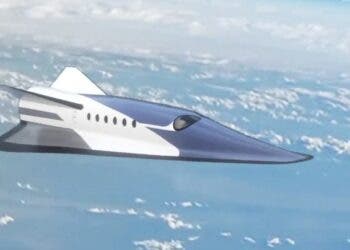
Three times faster than the retired Concorde, this hydrogen-powered hypersonic plane could take off from New York and land in London before the passengers would have been halfway through watching Top Gun: Maverick.
It’s been over two decades since the mighty Concorde made its final flight. Since then, commercial aviation has missed supersonic travel. However, interest in supersonic and hypersonic air travel has surged. Many companies worldwide are designing jets that attempt to overcome the Concorde’s flaws.
Now, Spanish designer Oscar Vinals has unveiled another revolutionary concept: the Sky Magnetar. This hypersonic aircraft promises to make the transatlantic journey in just 50 minutes. The current undefeated record for the fastest time between New York and London is one hour and 54 minutes, set in 1974 by a Lockheed SR-71 Blackbird. The record for commercial flights is two hours and 52 minutes, set on 7 February 1996 by a Concorde.
Sky Magnetar: A New Era of Speed

The Sky Magnetar resembles a futuristic, more aerodynamic space shuttle. The name is inspired by magnetars, a type of neutron star with magnetic fields billions of times stronger than Earth’s. According to Vinals, it’s designed to fly at speeds of 4,200 mph (Mach 5) — over three times faster than the Concorde. This is possible thanks to its two combined cycle engines located at the rear of the aircraft. These would enable the Magnetar to operate at subsonic, supersonic, and hypersonic speeds.
For subsonic speeds, the aircraft will use a bladeless Dyson jet engine with six turbines. At hypersonic speeds, the propulsion system transforms into a rocket engine, utilizing a sophisticated combination of airflow control, a plasma chamber, superconducting magnets, a combustion chamber, and a bypass ramjet engine. The propulsion system uses hydrogen rather than jet fuel, making the Sky Magnetar an emissions-free aircraft. If the latter statement made you scratch your head, more on that latter.

The Sky Magnetar features a sleek, aerodynamic fuselage with a low drag coefficient. It measures 112 meters long and has a quad-wing design optimized for performance at various speeds. The aircraft would have heat shields made of fiber-metal and ceramic matrix composites to protect it from the extreme heat generated by air friction at hypersonic speeds. Carbon-carbon composites will be used in the nose cone and leading edges, providing high thermal conductivity, corrosion resistance, and stability at high temperatures.

The fuselage includes an active cooling system that uses hydrogen gas from the fuel cell to manage heat. Interestingly, traditional windows are absent. Vinals reckons that the cruising speed is much too fast to enjoy the view, which would be quite dizzying. Instead of on the side, the Magnetar’s portholes are located on the roof of the plane for a more spacecraft feel. However, each seat — stacked in two-by-two rows — has screens for entertainment.

The Sky Magnetar could accommodate 100 to 120 passengers. It is designed to be operated by two pilots and an AI-based system capable of flying the aircraft.

Lessons from the Concorde
The Sky Magnetar represents a significant leap in aviation technology. It promises to reduce transatlantic flight times drastically, potentially transforming business and luxury travel. But will it ever lift off the runway? First and foremost, the Spanish designer needs a big-time investor and no one seems to be clamouring to throw money at this project.
After all, there’s a reason why we don’t have supersonic commercial flights anymore. The Concorde was retired in 2003 due to a combination of economic, environmental, and safety issues. One of the main factors was its high operating costs. The aircraft burned fuel like wildfire, making it expensive to operate compared to other commercial planes. Additionally, maintenance costs were substantial because the Concorde required specialized parts and services. With ticket prices being extremely high, only a limited market of wealthy passengers could afford to fly on the Concorde, making it financially unviable for airlines in the long run.

Environmental concerns also played a role in its retirement. The Concorde’s engines were incredibly noisy, particularly during takeoff and landing. Its sonic booms, produced when breaking the sound barrier, restricted it to transatlantic routes over the ocean to avoid disturbing populated areas. Furthermore, the aircraft’s high fuel consumption contributed to significant greenhouse gas emissions.
The final blow came with the tragic crash of Air France Flight 4590 in 2000, which raised serious safety concerns. Although this was the only fatal crash involving a Concorde, there were just too many factors stacked against supersonic flights. This incident, coupled with a general decline in demand for supersonic travel following the 9/11 attacks, sealed the fate of the Concorde, leading to its retirement.
Just a pipe dream?
The Sky Magnetar reportedly uses hydrogen fuel cells, which at face value sounds absolutely ridiculous. Although huge aerospace corporations like Boeing and Airbus have expressed interest in hydrogen — which releases no carbon dioxide and emits 90% less nitrous oxides — the current state-of-the-art is pitiful compared to the Magnetar’s ambitions. The largest hydrogen-powered airplane demonstrated thus far is Universal Hydrogen’s 40-passenger regional airliner, which in 2023 flew for a whopping 15 minutes.
The problem with fuel cells is that they can’t convert hydrogen and oxygen into electricity fast enough to sustain a trans-Atlantic flight. Their promise is to reduce emissions in the aerospace sector for short-haul flights. So hydrogen sounds like a nice marketing gimmick, but it’s totally unrealistic in a supersonic context. However, nothing is stopping this concept from using good old-fashioned jet fuel. Well, that’s if you don’t count the couple of billion dollars required to build it.
Overall, the Sky Magnetar is a very interesting concept. Its innovative design and technology could pave the way for the future of hypersonic air travel. And who knows, if realized, it would mark a new era in aviation, where crossing the Atlantic takes less than an hour.






